|
ESCAPE FROM CANCUN
Lessons About Human Reactions to Peak Oil and the Desperation to Conceal It
Psychosis in the Media and the Masses
by
Michael C. Ruppert
© Copyright 2005, From The Wilderness Publications, www.fromthewilderness.com. All Rights Reserved. This story may NOT be posted on any Internet web site without express written permission. Contact admin@copvcia.com. May be circulated, distributed or transmitted for non-profit purposes only.
[Everything that you are about to read is a near-perfect analogue to the way the human race is responding to Peak Oil, only compressed in time and with consequences far less severe than what is approaching with the winter of 2005-6. Explain that to the estimated 40,000 tourists who – for the most part – stranded themselves in Cancun during Hurricane Wilma. The warnings were there. They had a chance to prepare and leave but most of them chose not to. Their reasons for not paying attention may have varied; but for all who were stranded the results were the same. They paid the price for their choices. They just couldn’t believe that something bad might happen to them. It was not in their experience.
Here in the “safe” world, there are also signs of a near-contagious delusion, even among so-called experts, that does not augur well for large-scale adaptivity and survival in the face of Peak Oil. This story shows how easy it is to fool oneself. – MCR]
Nov 8, 2005 0800 PST (FTW), CANCUN / XTAPA – I was hoping for a break and some rest in Cancun, but it was not to be. I was scheduled to arrive on October 18th and depart for another conference in Xtapa where I was to give a lecture on the 22nd. Human plans are frequently nature’s entertainment and once again I lived up to a nickname I was given two decades ago when I was with the LAPD: “S--- Magnet.”
Having watched the earliest beginnings of Hurricane Wilma I was apprehensive even as I left Los Angeles on Tuesday October 18th but it was a necessary trip. I was to speak about a new product called Armorware which offered an elegant and bulletproof solution for millions of people searching for internet privacy and confidence. The Canadian company Armor Technologies, Inc. was just about to go public in a way that would allow millions of people who needed such a solution to get it.
For about eight months I had been involved in the marketing strategy for this new software platform. Some of my recommendations for its functionality had actually been incorporated into the final product. As Armorware was nearing its public launch and IPO, I was called on to act as spokesman for the product at a conference for mid-range independent Canadian investors. The conference was being held at the Moon Palace resort in Cancun and my tickets, as well as the presentation itself, had been arranged almost at the last minute.
Why me? I had written extensively about PROMIS software in FTW and Crossing the Rubicon. I had made friends with most of the principals of Armor Technologies at other conferences over the last three years. We shared similar political and economic views. Though not a techie by any stretch, I did understand the needs of individual computer users. While there was nothing out there that could stop Total Information Awareness (under its myriad names and incarnations) from accessing corporate, commercial and government data bases, there was – at last – something that absolutely guaranteed the sanctity of one’s own PC, personal files, and even e-mail correspondence and online transactions. And it was transportable and could be easily used from almost any computer, anywhere in the world. It was the right product at the right time.
I was never to make that presentation in Cancun. Instead, I was to receive a perfectly compressed, first-hand look at how the human race is responding to Peak Oil and maybe just a little understanding as to why the resistance has been so fierce, even nasty, for all these years.
By late Tuesday night it was beginning to look like Wilma was becoming dangerous. Once I hooked up to the net in the room of Armor’s CEO, Mark Seaton and visited the web sites for the National Hurricane Center and NOAA (National Oceanic and Atmospheric Administration) it only took about an hour to see that Wilma would indeed threaten Cancun. Watching Katrina and Rita evolve, strike, and do their thing in Louisiana and Texas had proved to be great schooling on hurricanes.
Once I decided that Wilma would at least brush by Cancun, and after looking out the 75 yards from my hotel room to the unprotected beach, I faced the problem of trying to alert people. I started at around 10 PM Tuesday. Wilma was still way out at sea, hundreds of miles away. But it had blown through Cat 3 like a dragster and was well on its way to Category 5. The first person I needed to convince was Seaton, a long-time friend and Armor’s General Manager and Acting CEO. The first time I warned him of the projections from the National Hurricane Center it didn’t click. Mark had a lot on his mind, like finishing the presentation I was to deliver the next morning. His assistant Patti, however, started paying attention right away. The second time, Mark stopped over my computer and looked at the image on my screen.
“Holy shit.”
“Yeah, Holy Shit. And it’s getting bigger. It could be a Cat 5 by tomorrow and the probabilities look good that it’s headed in this direction,” I responded.
“Keep me posted.”
That, I did.
Just after midnight it became clear that Wilma had zeroed in on the Yucatan peninsula. I downloaded a nine-minute-old teletype from a C-130 hurricane chaser stating that it had just recorded the lowest barometric pressure of any hurricane in the western hemisphere -- ever. Wilma’s course had swung westward and, measuring the width of the storm, it was clear that Cancun and Cozumel would be hit hard. At minimum, the eye wall would pass just a hundred or so miles offshore.
When I laid out the probabilities, the strength, size and course for Mark he wasted no time. There was no hesitation. Even though it was not his conference he had resources and he knew something had to be done. Quickly I Googled around and found out that Merida was the closest major city and that there was only one road out of Cancun. Remembering New Orleans, I wondered how big the road was and how well it would hold up under a mass evacuation. The road was only four lanes wide but there was no other option. I figured that the airport would be a overflowing by morning. I was wrong.
Time, however, was critical.
By 1 AM Mark and I were in the lobby talking to management at the Moon Palace. Mark arranged for buses to evacuate about a hundred and forty Canadians and also made sure that they had hotel rooms in Merida when they got there. His wallet and his heart were open and I was glad he was there.
Back up in the rooms, Patti was making calls and getting information on how to upgrade a chartered Lear 25 to a larger size jet for the next stop on our trip, another conference in Xtapa. Mark had planned for us to fly to Xtapa on Saturday. There were also children at the hotel and Mark was going to make sure that he got as many of his people out as possible.
The hotel staff thought we were crazy and they told us so. “We’ve had hurricanes here before. It’s no problem” they said. Don’t worry. “We’re not worried about it. We’ll tell you in plenty of time if there’s a problem.” I told them of the NHC reports but nothing registered. Deaf ears, polite smiles. Nothing was being done.
The organizer of the conference and some of the attendees joined us in the quiet lobby. Mark had made a deposit on the busses and reservations were being made at a large hotel in Merida. At four hours away by road it might get a good tropical storm but it wouldn’t face a hurricane. Still, some of the attendees didn’t quite grasp the danger. It’s hard to worry when it’s a beautiful night and there’s a fresh margarita in your hand.
One woman observed, “I don’t want to leave until I know about the money I paid for my room. Will I get that back?”
Three other people just ignored us and walked away. One man nearly panicked. The important thing was that the conference organizer had been convinced (I was later to hear second-hand that the organizer would receive all the credit for Seaton’s decisive actions; no surprise there). The Canadians would leave the next afternoon. Mark and I went back to the room and I resolved to start saving computer images from NOAA. Patti told us that a larger Saberliner 80 had been arranged and could pick up nine of us on Wednesday at 2 PM for the evacuation flight to Xtapa.
We all went to bed around 2:30 and were up by 7. Surprisingly, having made both a plan and a decision, we slept like babies. It surprised all of us.
The next morning our fears had proved to be justified. There was no doubt that Cancun was going to take a big hit. I saved an NOAA image which was timed using Eastern Daylight time (one hour later than Cancun).
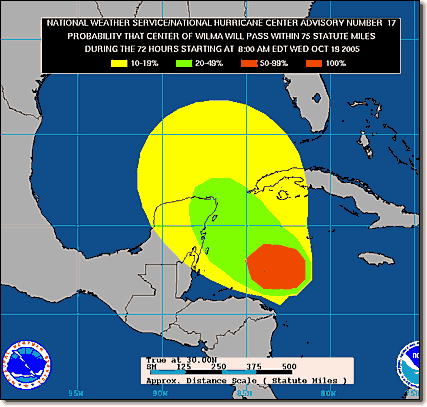
Those of us who were leaving on the chartered flight at 2 PM had been packed by about 9AM. Mark Seaton held discussions with many of the Canadians and their conference organizers. He had not hesitated to scrub our planned presentation on Armorware. “There are times”, he observed “when making money or selling things doesn’t matter.”
Wondering what the mood was like among several thousand hotel guests I began touring the enormous resort sitting on that vulnerable beach. I took time out to return to my computer and check for updates. By 11, it had become clear that Cancun was going to take a direct hit.
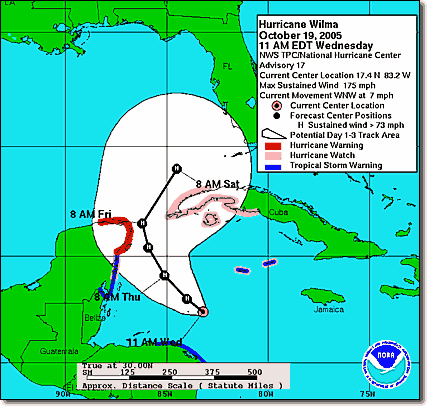
What were the tourists doing?
Most were busy about the task of being tourists even though from my rough polling it was clear that most had heard a storm was “out there.” Many tourists were actually booking tours to swim with the dolphins. I figured that the dolphins were smarter than that and had left on an Aero Mexico flight the night before. Even at noon, the pool was crowded and the swim-up bar well populated. There wasn’t a cloud in the sky. The wind was blowing but that was not unusual for Cancun and it was hard for many to reconcile news reports of the now Category-5 hurricane with their senses. It was much easier to sunbathe, drink and relax. There was always mañana.

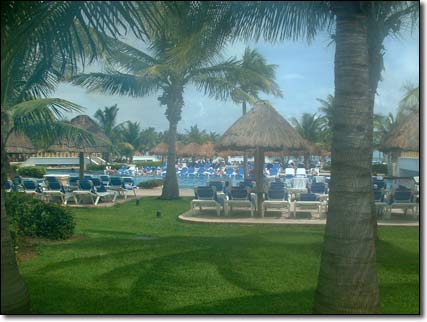
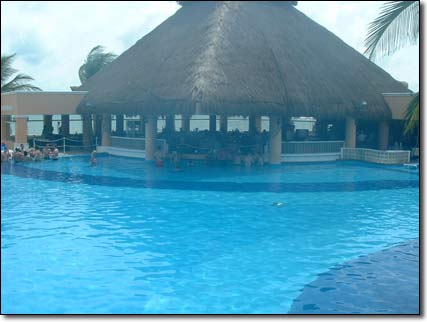
|
| Condensation clouded my lens as I photographed the crowded pool. Wilma is coming and no one appears the slightest bit concerned. |
Having had some bitter experiences with Peak Oil I guessed at the best way to broach the subject. While a part of me wanted to stand on a bridge joining two large pools and just start yelling that a Cat 5 storm was coming, I realized that that would make me look hysterical and minimize any positive impact I might have.
Instead, I opted to just quietly approach several groups of people and soberly talk to them. The first group I approached was two women and three men from the Midwest.
“Excuse me, my name is Mike and I’m a journalist getting ready to leave the hotel. Are you guys aware that a Category-5 hurricane is heading right this way and that the eye is expected to hit Cancun? It’s the most powerful hurricane in recorded history.” I offered the latest updates from NOAA.
One woman in the group started sobbing. She had been watching the news. She turned to her husband. “I want to get out of here now. I’m scared. This isn’t right. We’ve got to leave.” The men looked at each other and quietly agreed. “Yeah,” said one, I’ll bet the airport’s going to be packed. We’d better get there soon and see if we can get out.”
After a few minutes of quiet talk I wished the group well and next approached a group of three men and three women, all in their twenties. They had obviously been drinking for a while.
“Aw, it’s not that big a deal” they said. “We asked some other folks here and they said they weren’t going to do anything. It’s just a little wind and rain. The storm’s going to hit Cuba anyway.” They all laughed when one of them wryly commented, “It’s just that much more tequila for us.”
No point in arguing.
Next I approached a middle-aged couple reclining by the pool.
“Oh stop being a hysterical pussy,” the man said loud enough for about twenty people to hear. “Go bother somebody else.”
I went back to the lobby to check on our group. We were all packed and assembled. Seaton was helping coordinate the buses for Merida that would be leaving shortly. There was still very little indication in the sky of anything unusual. Only a few bands of frail clouds could be seen, albeit in the easily recognizable pattern of the outer bands of a storm which was now almost 400 miles across.
I was a bit optimistic for a moment when a group of people gathered right by the main entrance. It looked like people were taking notice. But then half of them left to get on a tour bus for Mayan ruins, fishing, and dolphin swimming. By now it was a virtual certainty that Cancun would take a direct hit from the eye wall which had just turned westward again.
I put my journalist hat on and approached a public relations manager at the Moon Palace named Nancy Guillen. In my broken Spanish and her pretty good English I learned that hotel management wasn’t the least concerned about Wilma. Guillen told me that every hotel had shelters in the city (all at sea level or just a few feet above) capable of housing several hundred people on cots. They had blankets (hardly necessary) and lots of fresh water (no mention of food, which turned out to be the biggest problem). Besides, Guillen told me that the hotel would not issue warnings to its guests until the government of the Mexican State of Quintana Roo told them to. Guillen was open, professional and calm. That was reassuring even if I thought she was mistaken. I wondered how many shelter beds there were in the city and if there truly were enough.
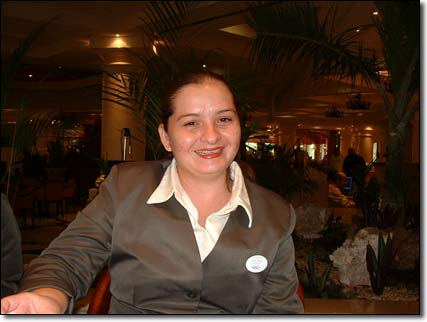 |
Public Relations manager Nancy Guillen assured us that everything was under control but stated that the hotel could not warn guests until the government instructed them to do so. |
By 1:20 there was a little more activity as taxi cabs and shuttle buses were taking maybe ten per cent of the guests to the airport. The rest were still taking people out on excursions. I asked a few who were leaving if they had called the airlines first and most said no, they were just going and willing to take their chances. A quick dash back out to the pool showed that very little had changed. It was party time and the day was young.
The nine of us who were to leave on the chartered Saberliner boarded our van and headed for the airport. There were signs of relief on everyone’s faces as we pulled out. Two-year-old Gray Putnam, son of David and Heather Putnam of Toronto, was a bit cranky at having been awakened from a nap but that was it. I marveled at the contrast in attitudes between our van and the pool bar. The clouds only hinted at Wilma’s imminent arrival.
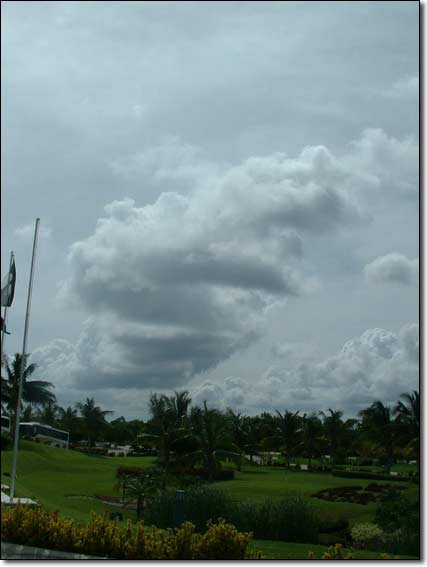
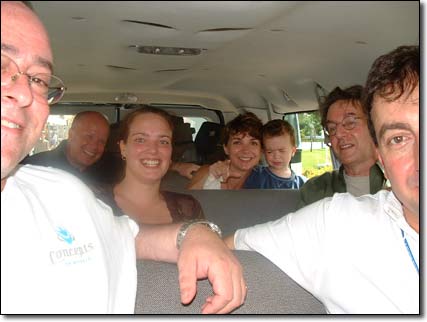
We arrived at Cancun’s private Fixed Base Operator (FBO) where the Saberliner was waiting. Mark Seaton posed for a picture with the pilot and the plane. I had visited Cancun three times previously and, curiously, there was no rush at the airport. Planes full of arriving tourists were still coming in.
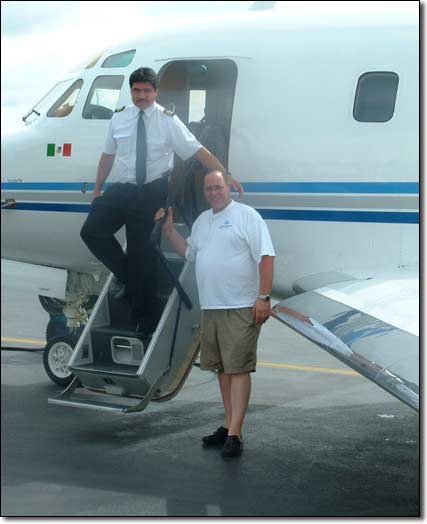
We filled the Saberliner to the gills. Luggage was stacked everywhere, blocking access to the restroom. It didn’t matter. Urinating into Tupperware was no inconvenience at all. A week later I was to see a photograph of the terminal we had departed from. It had been completely destroyed.

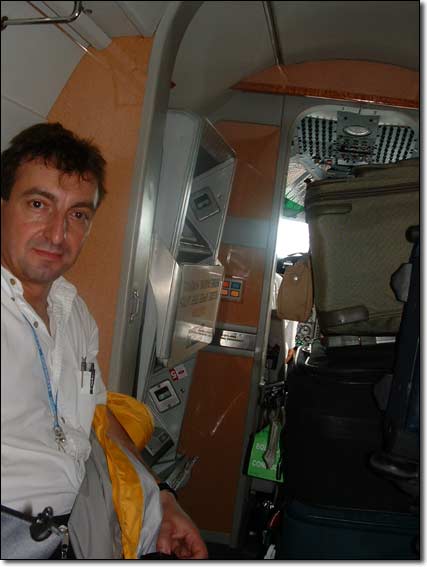
As we took off, the ominous advance clouds of Wilma’s leading edges were clearly visible. Someone told us that the airport would be closed by 10 or 11 PM that night. So much for all the people who decided they would wait to see how things looked tomorrow and then try to get out. They were gong to be sorely disappointed (and stuck, too). Simple math revealed the truth as it always has with Peak Oil. There were an estimated 50,000 tourists in Cancun. The airport had a capacity (under the best of conditions) of flying out maybe 7,500 per day.
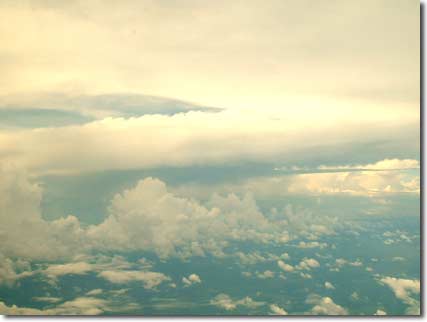
After Wilma had parked herself over Cancun and nearby Cozumel for 48 hours and a day of hurried repairs, the capacity for evacuation flights from the Cancun airport would be reduced to between 5,500 and 6,000 people per day. It was clear that a whole lot of people were going to be very unhappy for a long time.
Recalling that the US Congress had passed weather control / modification acts in 1970 and 1976 (another bill was introduced after Katrina and Rita) I thought of a recent and very surprising program on the Discovery Science Channel aptly titled “Weather Modification.” I had been amazed at how much was actually revealed about how technologies like HAARP could be used to steer hurricanes. [The big hurricanes were not created by the US government, but I have no doubt that their courses were shifted by a few degrees so that they would impact less-expensive real estate.] I thought to myself that if I was the US government I would see to it that Wilma parked directly over the Yucatan for a couple of days before heading to Florida. Hurricanes weaken over land and Cancun was the only land available for that purpose. Florida was, after all, Jeb Bush’s state.
Of course, that’s exactly what was to happen.
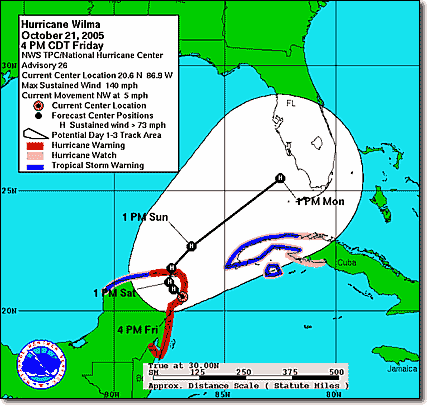
Once airborne, the mood in our little jet turned cheerful. We had dodged a bullet. On the way to Xtapa for the next conference the skies cleared and we enjoyed the post-adrenal high that always accompanies a close call.
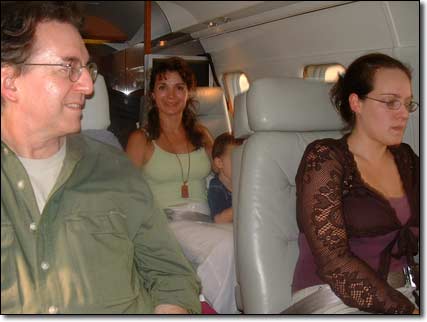
When we landed at Xtapa airport – after hurriedly running to the baños – we all looked at the cloudless sky and smiled. I thought to myself, “That’s the way it is with Peak Oil. If even for a moment we can fill up our gas tanks and convince ourselves there’s no storm coming, we can think that somehow we are immune. We can go back to business as usual. We can pretend there is nothing to worry about.”
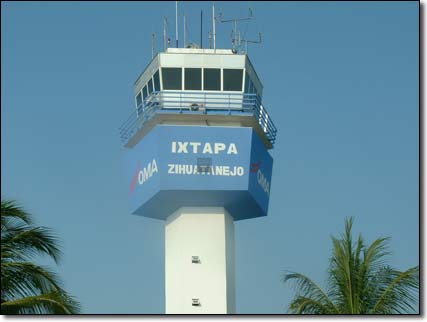
I thought of the callous, willful and even criminal dishonesty with which the media continues to reassure us after Katrina and Rita that everything is OK because gasoline prices are falling and crude oil prices are slipping. They, and the American government, neglect to tell us that this is only because we are in the merciful season when both air conditioners and heaters are turned off; when driving vacations have ended. They neglect to tell us that prices are low because the US is tapping a now impossible-to-refill strategic petroleum reserve of only 700 million barrels and receiving 800,000 barrels a day of mostly refined gasoline from the 22 member countries of the International Energy Agency (IEA). They aren’t telling us that our refining capacity is still heavily damaged and our production capacity is hobbled. They neglect to tell us that 108 offshore rigs and a still undisclosed number of pipelines constituting about 75% of American natural gas production and sixty per cent of our domestic oil production are shut in for between six months and three years (under the best of circumstances). They neglect to tell us that IEA energy “loans” will end forever with the first cold snaps of winter.
But still the evidence is there, just as clear as it was for me and others in Cancun that a much bigger, deadlier storm is approaching and that escape from it will not be easy.
Almost 40,000 tourists, mostly American, were trapped in Cancun for up to eight days. They slept on floors without mattresses and had no showers. They had fresh water but some went two and three days without food. They were humbled and they were evacuated only as air service slowly returned to normal. As for Cancun itself, it was pretty well trashed. The problems there are the same as with New Orleans. While most of the luxury hotels have announced they will be rebuilt within six months, they fail to discuss the fact that the homes of most of their employees may never be rebuilt at all.
Collapse of complex civilizations tends to be much easier to start than to stop. There are a hundred, maybe a thousand things that can go wrong and will go wrong. Cancun was a lesson for all of us. Humankind’s biggest lesson of all time begins this winter.
Postscript: In scouring the web I was able to find some pictures of the damage done by Wilma to Cancun and Cozumel. I found pictures of stranded tourists and one picture that looked a little like the guy who called me a hysterical pussy. I recalled the old line, “Been there, done that. Got the t-shirt.”
I hope it was worth it, buddy.
The warning signs of Peak Oil are, in fact, much more well-defined and numerous than they were even for Wilma. A few people are getting it and taking action. Most are not. But the part that makes me bitterly angry is the degree to which the government, corporate media, and the financial markets are maliciously and deliberately deceiving most of the public.
Should these folks ever ask for absolution I’m afraid I will not be the one to give it.
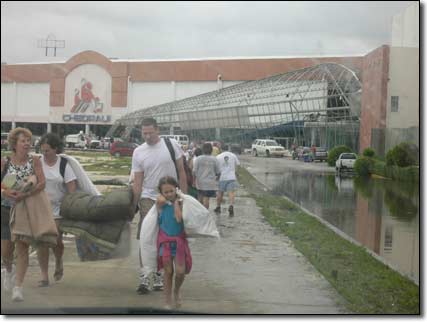
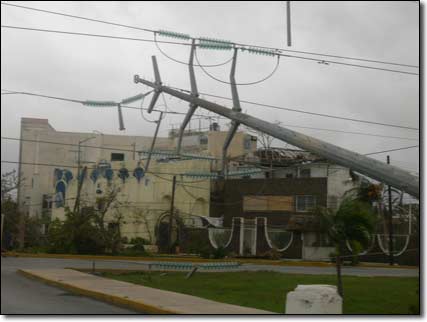
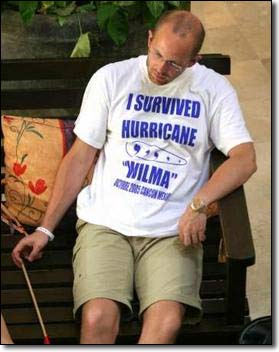

Please Note
This function has been disabled.
|
|
|
|



